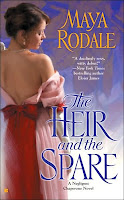
A few weeks ago, I did something I know people here at Risky Regencies will sympathize with–I ordered a couple of books from abebooks, and when they arrived realized I already had them. Ooops. (The duplicates will probably pop up here as a giveaway soon, so stay tuned!). Then I knew it must be time for a Book Check.
I do this once or twice a year, going through my shelves, the stacks of books on the floor, and the plastic storage tubs of books. It gives me a chance to do some much-needed dusting (I am really glad you can’t actually see my house, because honestly housekeeping isn’t my forte), find books to donate to the library book sale (though this doesn’t really often happen–I think I got rid of all of 2 books last time), and see what I have that I might have forgotten about (and thus not order them again). This process takes quite a while, as I usually end up sitting on the floor re-reading stuff or looking at pictures in art books.
One book I found hiding on the shelf this time was Benjamin Woolley’s Bride of Science: Romance, Reason, and Byron’s Daughter. Ada Byron, Countess of Lovelace, aside from her father (who she never knew, of course, her parents having separated so acrimoniously when she was an infant) was a very interesting person in her own right. Raised by her wackadoo mother in an uber-strict manner, emphasizing science, logic, and morality (i.e. the anti-Byron), she was a part of the early Victorian interest in new technology and science. She was a gifted mathematician (something about using punch cards to calculate Bernoulli numbers, and an interest in the concept of imaginary numbers), and although some of her interests were, er, questionable (mesmerism and magnetism, and later using her own mathematical system to lose disastrously at the horse races) some was of lasting impact. She worked with her friend Charles Babbage on an invention called the Analytical Engine (this is where the punch cards came in) that is considered an early forerunner of the computer. She died at 37 (still harangued by her mother) and was buried next to her father, but her influence can still be seen–the US Department of Defense called their computer language “Ada.”
I’ve often said that the one kind of hero or heroine I could never write about would be a mathematician. I’m a terrible dunce with numbers–they lost me somewhere around first grade with those pesky multiplication tables. In school, my abstract brain preferred things like analyzing poetry, where there was no “right” answer. After all, who can say what “Disillusionment of Ten O’Clock” really means, yet 2+2 is always 4 no matter how you might feel about it at the moment. I’m so deeply impressed by people like Ada (or like my future sister-in-law, an engineer) who are good at such things. They’re so mysterious and strange to me. It would take an immense amount of hard research to make any mathematical character I wrote about believable. And yet inspiration is a strange thing. A heroine who is interested in algebra has taken up residence in my mind, and may one day have to come out on the page (though she is in line behind at least 4 other projects, all with stubbornly non-scientific heroines).
What were your favorite subjects in school? Any that you hated? What sort of character would you feel challenged to write or read about?
And be sure and sign up for our Newsletter at riskies@yahoo.com, with “Newsletter” in the subject line. I promise there will be no pop quizzes, math or otherwise, just fun news and contests!







